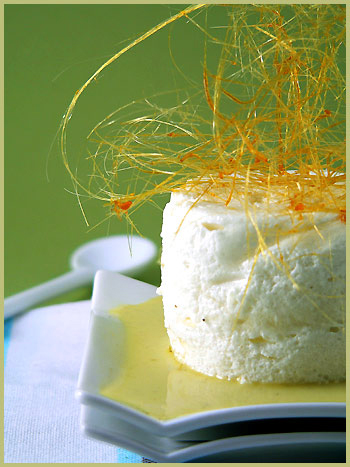
So here we are, I am going to tell you the story of my island and how it happened.
My Island
What is the difference between an île flottante and oeufs à la neige?
Do you get confused like I have in the past? They look the same, they taste closely enough, yet they are slightly different and let me tell you why. Or at least how I learned it recently.
Îles Flottantes could simply be a more elaborate version of Oeufs à la neige.
Îles Flottantes own a special ingredient that Oeufs à la neige lack. In short, the culprit is caramel. Will you remember this? The difference is so minimal that we should not focus on this. Aside from the caramel, the ingredients are pretty much the same.
My story about my island has to do with my older and only brother Benoit.
When I was growing up, I think Benoit thought I was a pain at times. I am not sure why that could happen as I was simply the most adorable little sister. Of course I was! So once in a while, I had to find a way to win Benoit’s favours. Whenever I needed something from him, the smart one that I was cooked something he liked. And he simply loved îles flottantes.
And so very often at home, we would have îles flottantes. Don’t think that it is because I often needed to be forgiven for something! What are those islands? A crème anglaise (custard) made from eggs/milk/vanilla on top of which is placed a light “meringue” made out of egg whites and sugar, and cooked in water or milk (or not as we will see in this recipe). With caramel. I also learned that this dessert that I really thought was fully French exists in many other cultures, such as Argentina as an example, as told by my good friend Pato.
I had been planning to write about îles flottantes for a while and was about to post my story when I recently came across a copy of the recent magazine Living where Martha Stuart gives her twist to the traditional recipe: a pistachio-flavored ile flottante. “Intéressant!”, I thought. I loved the picture for the recipe right away but not so much the recipe. “Never mind” I thought, cela, je veux le faire! ( I want to do this!) In Martha Stuart’s recipe, the crème anglaise calls for cream on top of milk, which I am imagining to be very rich, if you think that the custard is already using whole milk, egg yolks together with sugar. It could be very nice no doubt, but I wanted to keep mine the way I knew and had learned it. So although I kept her brilliant idea of the dessert composition, I ran away from the recipe itself, and stayed with mine. She also used cream of tartar for the meringue which I am simply foreign to as I never came across the equivalent in France. What is it? What do you do with it? Does anyone know? So I kept my egg whites without cream of tartar but tested with the pistachio flavor, although the traditional flavour is vanilla. I enjoyed it but since I am very fond of vanilla, I would go back to the flavors I grew up with: vanilla and orange essence. You can basically choose the flavor you prefer. And oh, did I mention that the fun was absolutely in the making of the caramel, which I had never tried before. Imagine long thin threads of golden caramel that seem to appear from nowhere as they fall down. I even tried to pull on them and they became bigger and bigger. I loved to do those and am already thinking of so many other uses for them, even if I am not a caramel fan. They just look too pretty! Pastry chefs must be having such a blast doing those kinds of things the kitchen!
And to finish, it is worth mentioning another reason why I had to talk about my love for îles flottantes: invariably, whenever I go to a Brasserie or a restaurant in France, even when the list of desserts is long and fancy, if îles flottantes are on the menu, what do I get?
Cela (this):

They take me back to my childhood and my brother. How can you resist a bath of vanilla on top of which swims such a lovely puffy sweet cloud? My brother never did! The perfect tool!
Et voilà!
You need :
For the custard
- 5 egg yolks
- 2 cups + 2 Tbsp whole milk
- 2 oz sugar (I use evaporated cane sugar)
- 2 to 3 Tbsp pistachio paste (or 1 Tbsp orange essence)
For the meringue
- 5 egg whites
- 1 cup sugar
For the caramel
- 1/2 cup sugar
- 1/2 cup corn syrup (I actually used cane sugar syrup)
- 1/2 tsp beewax (bought on line, many places carry it)
Steps:
For the meringue
- Preheat your oven at 250 F.
- Take 6 ramekins and spray the inside with vegetal oil.
- Take a metallic bowl and put the egg whites and sugar in it.
- Place over a pot full of simmering water and mix until the sugar is dissolved.
- Then using your mixer and away from heat, whip the egg whites until they are firm and form a meringue.
- Use a confection bag and fill the ramekins with the egg whites (to help prevent air pockets).
- Make an even surface.
- Place the ramekins in a deep oven dish and pour hot water as high as half the height of the ramekins.
- Cover with a piece of foil paper and place in the oven for 20 mns or until firmer.
- Take out and place the ramekins in the fridge for an hour minimum before unmolding.
For the custard
- Bring the milk to a first boil then reduce.
- Beat together the sugar and the egg yolks until lighter and white.
- Pour 1/2 cup milk in the egg preparation while stirring constantly, then add the rest of the milk and the flavour (pistachio of orange).
- Place the pot on medium to low heat again to thicken the cream while stirring constantly. It takes about 10 mns or so, until the cream coats the spoon (which means it is ready).
- Strain it and place it in a bowl plunged in iced water so that it cools down.
For the caramel
- Protect your floor with newspaper.
- Tie two wooden spoons on your counter, side by side, handles sticking out (use tape to secure them).
- Spray vegetable oil on the handles.
- Tie together 2 forks with their teeth pointing outside.
- Melt the sugar and corn syrup in a pot.
- Bring the temperature to 300 C.
- Stop the heat and let rest for 2 mns, before adding the grated beewax. Mix together.
- Check the temp. and when it reaches 250 F, dip the forks in the caramel.
- Describe movements from left to right at about 2 feet above the handles. Threads of caramel will form and fall. As soon as this happens, bring them in the shape of a nest. It goes quickly. I also suggest using it within the hour as it falls after that time.
To serve your dessert, you need to unmold the meringues on a paper towel to absorb some liquid, to use a cookie cutter to give it a nice shape (dip it in hot water), to place a meringue on soup plates, pour some crème anglaise around and decorate with the caramel nest, and mainly to eat. Savour every bite, this is one of my favorite desserts, with vanilla even more!
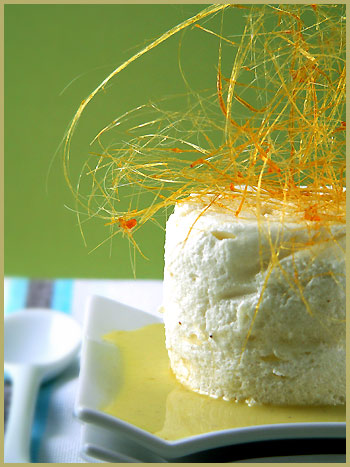
Ingrédients :
Pour la crème anglaise
- 5 jaunes d’oeuf
- 60 cl lait entier
- 60 g sucre en poudre
- 2 à 3 càs de pâte à pistache verte (ou 1 càs d’essence d’orange)
Pour la meringue
- 5 blancs d’oeuf
- 200 g de sucre
Pour le caramel
- 100 g de sucre
- 120 g sirop de glucose
- 1/2 càc de cire d’abeilles
Étapes:
Pour la meringue
- Préchauffez votre four à 120 C.
- Prenez 6 petits ramequins et graissez-les avec de l’huile végétale.
- Prenez un bol métallique et mélangez-y les blancs d’oeuf avec le sucre.
- Placez-le sur une casserole contenant de l’eau frémissante, jusqu’à ce que le sucre soit dissout.
- Ensuite, battez les oeufs et le sucre en neige ferme, pour former une meringue.
- Utilisez une poche à douille pour remplir les ramequins de meringue (pour empêcher les poches d’air)
- Égalisez la surface.
- Placez les ramequins dans un plat allant au four et remplissant-le d’eau (arrivant à mi-hauteur des ramequins).
- Couvrez d’une feuille d’aluminium et placez au four pendant 20 mns.
- Retirez-les et placez-les au frigo pendant 1 heure minimum avant de les démouler.
Pour la crème
- Faites bouillir le lait et réduisez.
- Mixez les jaunes d’oeuf et le sucre jusqu’à ce que le mélange blanchisse.
- Versez un peu de lait chaud sans cesser de mélanger, puis ajoutez le reste et mélangez bien. Ajoutez la pâte à pistache ou l’essence d’orange et mélangez.
- Placez la casserole sur feu moyen à doux pour faire épaissir la crème (sans cesser de remuer). Elle est prête lorsqu’elle nappe la cuillère (environ 10 mns).
- Passez-la au tamis et placez-la dans un bol plongé dans un bain glacé, afin de la refroidir.
Pour le caramel
- Protégez votre sol avec du papier journal.
- Attachez deux cuillères en bois l’une à côté de l’autre sur votre plan de travail (avec du scotch), avec les manches au-dessus du sol.
- Graissez les manches (j’utilise un spray d’huile de colza).
- Prenez deux fourchettes et maintenez-les ensemble, dos à dos, les dents vers l’extérieur.
- Faites fondre le sucre et le sirop dans une casserole tout en remuant.
- Faites monter la température jusqu’à 150 C.
- Arrêtez le feu et laisser reposer 2 mns, puis ajouter la cire râpée et mélangez.
- Vérifiez le thermomètre et quand il atteint 120 C, plongez-y les deux fourchettes.
- Décrivez des mouvements horizontaux, de droite à gauche, à à peu près 60 cm au-dessus des cuillères.
- Des fils de caramel vont se former (comme par magie) et tout de suite, assemblez-les pour former un nid. Utilisez-le dans l’heure qui suit car il a tendance à retomber.
Pour assembler votre dessert, il suffit de démouler les meringues sur du papier absorbant, de leur donner une jolie forme (utilisez un emporte-pièce trempé dans de l’eau chaude), de les déposer dans des assiettes creuses, de verser la crème anglaise tout autour et de décorer avec le nid de caramel, et enfin et surtout, de déguster!!
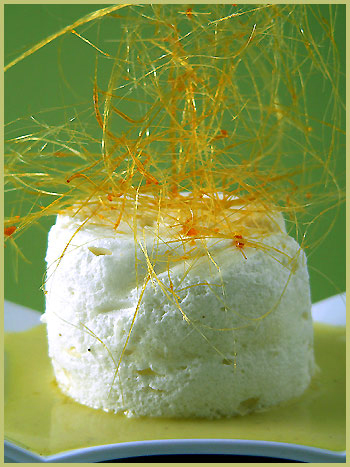

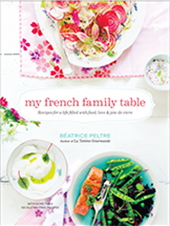
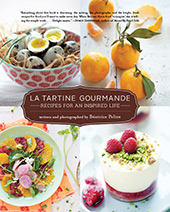
si je te dis Fabuleux, tes photos sont sublimes.
J’ai la cuiller à la main et je plonge directe dans crème anglaise.
“they taste closely enough…”: génial, Béa. And they will get together with the blanc-manges who want to win Wimbledon (it’s a Monty-Python thing), and conquer the world.
what an interesting dessert!!
Bea, cream of tartar is a byproduct of tartaric acid, itself a byproduct of the wine making process (it is technically the potassium salt of tartaric acid). Tartaric acid is usually encountered in wine as a crystal sediment that forms in fermenting vats and sometimes even on corks.
Cream of tartar (the potassium salt derived from the acid) has two uses: as a stabilizer for egg white foams (which is why your recipe calls for it) and also as a leavener like baking powder.
As for your iles flottantes, I’m very intrigued. I will actually be making something very similar in the coming days. Quite the coincidence! I especially love the creme anglaise, which is the greatest sauce ever invented.
Ohh yes I was so very very close!
A delightful sounding twist on a favoured classic, not to mention completely gorgeous!
This dessert is beautiful. I was hoping you could go into more detail on the process of making the caramel “nest.” Perhaps you could post pictures of the set-up, so that we can tell how far apart the spoons should be and how they should be oriented?
Also, is it possible that the nest would stay fluffed up longer if it were placed in the freezer?
How can you resist? Je ne resiste pas…
Là, tout de suite, comme ça, je ne trouve pas les mots. Comme toujours, c’est un choc esthétique allié à la saveur des produits. Renversant !
Comme d’hab., un plaisir!!!
Super miam!!!
🙂
You find the translation for the Cinnamon & Melon sorbet !!!
Bye Bea!
Too beautiful! I can see any transgression being forgiven for a dessert like that.
I can also only imagine the mess that would be made in my kitchen attempting to make the caramel flourishes!
bon, il ne me reste plus qu’à trouver de la cire d’abeille ! (c’est pas gagné)
Beautiful, Béa!
And thank you for explaining the difference! I have always wanted to try this but have been afraid. Meringue is a bit frightenting to me. You have given me the courage now.
Merci!
Beeee-yoooo-teeful!!! I love the idea of adding the pistachio flavoring. I’m curious about the beeswax in the caramel. I’ve never worked with caramel much, so I’m not so familiar with the different techniques…does it strenthen the caramel so you can spin it into threads?
Vraiment superbe. Bravo, ça a l’air divin!
Je prévoyais de faire quelques uns des desserts du MSL en question, dont celui-ci. Tes résultats magnifiques m’y encouragent.
Tenteras-tu celui au sorbet de champagne rosé? C’est le premier sur ma liste. 🙂
Bea,
What a cute story, I’m sure you were the best sister! I would be in heaven if my sister cooked me things like this. It looks stunning, wish I could have a bite =)
~Dianka
http://na-zdravi.blogspot.com/
Oh, Bea it’s beautiful, i don’t dare to eat it, it’s so gorgeous…
Hi Bea, this used to be one of my favourite desserts as a child–I’ve never seen it topped with this sort of caramel garnish, I love it! Most of the time, sugar garnishes are beautiful but sort of an afterthought just for prettiness, but here, it’s caramel colour and flavour are an essential part of the dessert, and the crunch is a perfect addition to the soft clouds and custard. Beautiful!
incredible, bea. so pretty!
SUPER BLOG !!! en anglais et en francais…extra, du tres beau boulot !
et les photos sont…..magnifiques !!!
Merci Anne, elle est ou ta cuiller? 😉 Tu vas en avoir besoin avec tes exams qui arrivent!
Ben, you are my language and cultural expert!
Kat, thanks
Rob, I should have asked you right away! You are the true food encyclopedia and I love it! I am curious to see what you are up to cooking! Hurry up!
Thanks Bron, it is a nice twist indeed, but I still prefer vanilla! Hard to change an old horse 😉
Barzelay, I will take pics soon and post them. Good idea! In the meantime, the spoons should be oriented handles sticking outside, above floor.
Gracianne, oui impossible de resister a une ile flottante!
Camille, merci, trop gentille que tu es!
Menus propos, merci!
Sandra, thanks so much my friend. I look forward to trying them!
S’kat, ahahh, no no, it is actually not that bad, put a lot of newspaper!
Laurange, peut-etre que ce n’est pas necessaire. Je ne suis pas experte en caramel, mais je me dis que ca doit bien etre possible sans. Sinon, moi, je l’ai trouvee en ligne.
Ivonne, I look forward to hearing your results!
Thanks Yasmin. I am not the caramel expert either 😉 so I think you might be describing right what it does but I tend to believe it is possible without the beewax. I should try.
Ah oui ZOubida, moi aussi je lorgne le sorbet champagne, aussi les souffles au the Matcha….
Dianka, I should take your word and think, yes I was the best sister! 😉
Fabienne, merci bien!
Tejal, thanks a lot!
Iamchanelle, thanks!
Flo, ravie que cela te plaise! A bientot!
Not only are your photos a visual feast, but the descriptions are delightful and almost make this dessert seem simple 😉 If only I could work up the courage to work with melted sugar – ack!
Pingback: M's Blog
je n’ai jamais vu d’îles flottantes aussi belles ! Je veux bien partir sur une île déserte avec tes îles flottantes !
Pingback: Vanilla, Cardamom Snow Eggs — Oeufs à la neige, vanille et cardamome by La Tartine Gourmande
This dessert is very popular in Chile. The local name, Leche Nevada
Pingback: Egg whites: a love story « I’m in the kitchen
bonjour. je n’ai jamais vu utiliser de la cire d’abeille dans une recette, d’où te viens cette idée, elle est interressante ?. J’ai 6 ruches et nous venons de faire notre recolte de miel, il est babuleux, je vais garder un peu de cire pour essayer.
merci pour ta reponse.